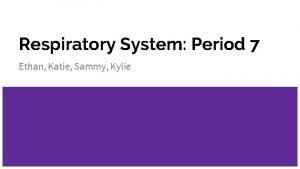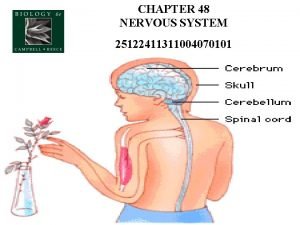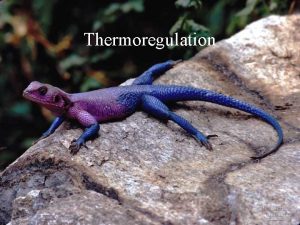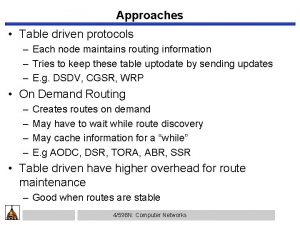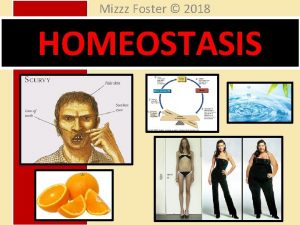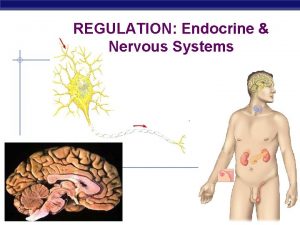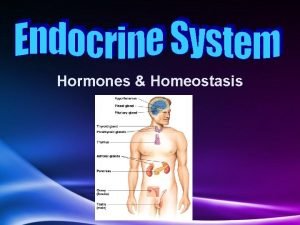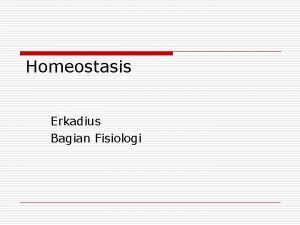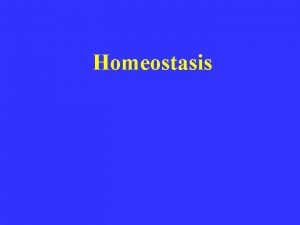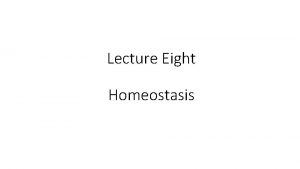REGULATION Nervous System The nervous system maintains homeostasis















- Slides: 15

REGULATION Nervous System The nervous system maintains homeostasis by controlling and regulating all other parts of the body.

Functions of the Nervous System 1. Sensory-uses receptors to gather information from all over the body 2. Interpretation-the brain then processes the information into possible responses 3. Response-sends messages back through the system of nerve cells to control body parts

Evolutionary Trends of the Nervous System Complex Simple Animal Taxon Type of Nervous Tissue Aquatic Invertebrates Flatworms & Roundworms Segmented Worms & Arthropods Vertebrates A simple system with interconnected neurons called nerve nets; contain specialized cells for touch and chemical detection Ganglia (a group of nerve cells) and nerve cords run along the body; can detect chemicals, touch, and some have eyespots Cephalization occurs which is the concentration of nerve cells in a head region to form a brain; intense senses in arthropods A well developed brain evolved from the spinal cord; the size and complexity increases from fish to mammals planaria, flukes, earthworm, ants, tapeworm, hookworm grasshopper, bees Picture of system Examples sponges, jellyfish mammals, birds, reptiles, fish, amphibians

Structures of the Nervous System Neurons: the functional cell that transmits signals through the body; an individual nerve cell Parts of a Neuron 1. cell body- the largest part of the neuron; contains the nucleus and organelles 2. dendrites- short, branching extensions spreading out from the cell body; receive and carry impulses to the cell body 3. axon- long, fibrous part of neuron; conducts nerve impulses away from cell body 4. at the end of the axon, the impulse travels across the synapse, a tiny gap separating the axon of one neuron from the dendrite of another

Neuron Nerve Impulse- an electrical signal is sent from the dendrite, along the axon, to the terminal. A chemical message, called a neurotransmitter is released from the axon terminals into the synapse, where it travels to the next cell.

Types of Neurons a. sensory neurons- carry impulses from sense organs to brain b. motor neurons- carry impulses from brain/spinal cord to muscles/organs c. interneurons- carry impulses between sensory and motor neurons

Divisions of the Nervous System • Central Nervous System (CNS) • Peripheral Nervous System (PNS)

Central Nervous System (CNS) A. Brain- “control center”- receives and analyzes information; processes and sends back instructions

Parts of the Brain 1. Cerebrum controls thought, language, learning, judgment, & voluntary action 2. Cerebellum controls involuntary functions of muscles & maintains balance and posture 3. Brain stem Controls involuntary functions such as breathing, heart rate, and swallowing 4. Thalamus, Hypothalamus Controls homeostasis- temperature, hunger, thirst, flight or flight responses

Spinal cord- link between the brain and PNS; also controls reflexes Reflex: a simple, automatic response (ex. Hand on a tack)

Peripheral Nervous System (PNS) A. Consists of nervesropelike bundles of neurons B. Gathers information, delivers it to and from CNS

Levels of Organization Neurons Nerves Brain Nervous

Interaction with other systems for Regulation Ø Bones of the skeletal system protect the spinal cord and brain. Ø The brain controls heart rate, blood pressure, and breathing via the circulatory and respiratory systems. Ø Glands in the brain control the release of hormones of the endocrine and reproductive systems. Ø The brain controls muscles both in digestion and movement.

Diseases / Disorders of the Nervous System 1. Polio- a virus that attacks the spinal cord; eventually causes paralysis 2. Multiple Sclerosis (MS)- affects neurons; slows nerve impulses, causing muscle weakness, possibly paralysis. 3. Alzheimer’s- brain tissue deteriorates; severe memory loss 4. Stroke- a blockage in a blood vessel in the brain, causing brain damage 5. Concussion- a bruise to the brain when the brain hits the inside of the skull

Fun Facts v. A human body contains more nerve cells than there are stars in the Milky Way v. Neurons are the largest cell in the body and do NOT undergo mitosis v. Nerve impulses move at 100 meters per second or more v. Longest axon of a neuron is 15 ft! (in the giraffe)
 How the respiratory system maintains homeostasis
How the respiratory system maintains homeostasis Bioflix activity homeostasis hormones and homeostasis
Bioflix activity homeostasis hormones and homeostasis Bioflix activity homeostasis high blood glucose
Bioflix activity homeostasis high blood glucose Nervous system homeostasis
Nervous system homeostasis What animals are cold blooded
What animals are cold blooded Homeostasis mechanisms for regulation of body temperature
Homeostasis mechanisms for regulation of body temperature Thermoregulation
Thermoregulation Negative feedback homeostasis examples
Negative feedback homeostasis examples Identify each type of neuronal pool
Identify each type of neuronal pool Sensory input and motor output
Sensory input and motor output Neuronal processes
Neuronal processes Pathophysiology of pulmonary hypertension
Pathophysiology of pulmonary hypertension Maslows theory maintains that
Maslows theory maintains that Unconcerned or nonissue approach
Unconcerned or nonissue approach In each node maintains a vector (table)
In each node maintains a vector (table) North america cargo securement
North america cargo securement
